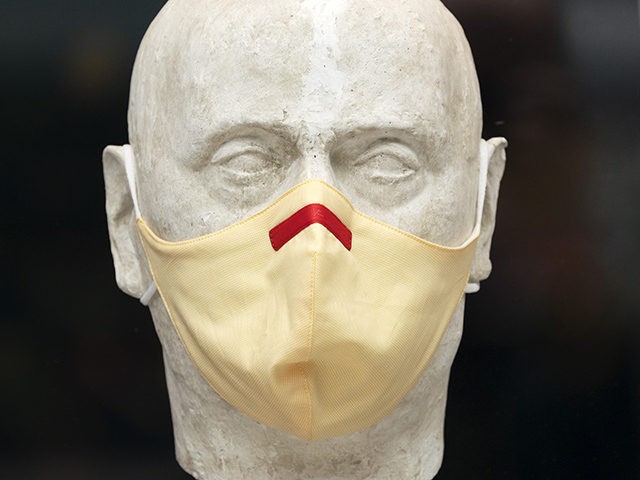The Centers for Disease Control and Prevention (CDC) on Wednesday published an early summary from a study examining ways to better maximize the fit for cloth masks, examining the efficacy of double masking.
The summary described experiments that researchers conducted to examine ways to improve the fit of masks, including double masking.
The CDC reiterated the claims of masks reducing exhaled respiratory droplets from wearers but said the effectiveness of the masks can be improved by securing the fit. Researchers, the CDC said, conducted “simulations” to “assess the extent to which two modifications to medical procedure masks … could improve the fit of these masks and reduce the receiver’s exposure to an aerosol of simulated respiratory droplet particles of the size considered most important for transmitting SARS-CoV-2.”
Modifications included “wearing a cloth mask over a medical procedure mask (double masking)” and “knotting the ear loops of a medical procedure mask.”
The CDC stated that it conducted the experiments using a “pliable elastomeric source and receiver headforms,” and researchers found that double masking could be effective to further reduce the spread of the Chinese coronavirus.
“The first experiment assessed how effectively various mask combinations reduced the amount of particles emitted during a cough (i.e., source control) in terms of collection efficiency,” the CDC wrote, explaining that researchers used a pliable elastomeric headform to “simulate a person coughing by producing aerosols from a mouthpiece.”
Per the study:
Results from the first experiment demonstrated that the unknotted medical procedure mask alone blocked 42.0% of the particles from a simulated cough (standard deviation [SD] = 6.70), and the cloth mask alone blocked 44.3% (SD = 14.0). The combination of the cloth mask covering the medical procedure mask (double mask) blocked 92.5% of the cough particles (SD = 1.9).
In the second experiment, adding a cloth mask over the source headform’s medical procedure mask or knotting and tucking the medical procedure mask reduced the cumulative exposure of the unmasked receiver by 82.2% (SD = 0.16) and 62.9% (SD = 0.08), respectively (Figure 2). When the source was unmasked and the receiver was fitted with the double mask or the knotted and tucked medical procedure mask, the receiver’s cumulative exposure was reduced by 83.0% (SD = 0.15) and 64.5% (SD = 0.03), respectively. When the source and receiver were both fitted with double masks or knotted and tucked masks, the cumulative exposure of the receiver was reduced 96.4% (SD = 0.02) and 95.9% (SD = 0.02), respectively.
The study identified both double masking and knotting or tucking as “two of many options that can optimize fit and enhance mask performance” but acknowledged that double masking could interfere with breathing or peripheral vision.
A CDC article titled “Improve How Your Mask Protects You,” last updated February 10, listed ways individuals can improve their own masks and suggested adding “layers of material.”
“Use a cloth mask that has multiple layers of fabric,” the CDC said in the guidance.
“Wear one disposable mask underneath a cloth mask,” the CDC stated, effectively advocating the practice of double masking. “The second mask should push the edges of the inner mask against your face.”
The recommendation coincides with remarks from Dr. Anthony Fauci, President Biden’s chief medical adviser on the coronavirus, who appeared to condone the practice, stating that it was “common sense” that two masks would likely be more effective than one. While he backtracked, explaining that there was no data indicating that double masking “is going to make a difference,” he later revealed that he “often” wears two masks himself.
Editor’s Note: The photo accompanying this article is not depicting any test conducted in this study but a mannequin in a men’s clothing store. It is illustrative and not literal.

COMMENTS
Please let us know if you're having issues with commenting.